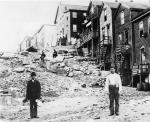![header=[Marker Text] body=[On September 6, 1869, a fire broke out at the nearby Avondale Colliery, trapping the miners. The eventual death toll was 110. This included five boys between the ages of twelve and seventeen, and two volunteers who were suffocated while attempting rescue. As a result of this disaster, Pennsylvania's General Assembly enacted legislation in 1870 which was designed to enforce greater safety in the industry. ] sign](kora/files/1/10/1-A-ED-139-ExplorePAHistory-a0a4s6-a_450.gif)
Mouse over for marker text
Name:
Avondale Mine Disaster
Region:
Poconos / Endless Mountains
County:
Luzerne
Marker Location:
US 11 near junction PA 29, Plymouth Township
Dedication Date:
September 1, 1994
Behind the Marker
In the 1800s, the American industrial revolution was fueled by coal, and northeastern Pennsylvania had the largest anthracite (hard coal) deposits in the Western Hemisphere. To extract the coal, tens of thousands of miners, first from the British Isles and then from eastern and southern Europe, poured into the region and provided the labor for what became one of the state's largest, most profitable, most dangerous, and most violent industries.
In 1869, Pennsylvania became the first state in the nation to pass mine safety legislation. But the state's laws were rarely enforced. In 1868, the state placed law enforcement in the hands of the coal operators, and for more than sixty years state government aligned with the coal companies, while coal miners lost life and limb at an alarming rate. In the 1870s, more than five workers per 1,000 died each year in accidents, a rate significantly higher than in British mines. Between 1869 and 1900, more than 10,000 mineworkers lost their lives and more than 24,500 were injured in Pennsylvania's anthracite district alone.
The most deadly of the state's mining calamities, which Pennsylvania's miners never forgot, occurred at the Avondale Colliery in 1869. In 1867, the Steuben Coal Company built a breaker directly above the single shaft at its Avondale Colliery. Like other mining companies at that time, it kept small fires burning at the bottom of shafts to create drafts that promoted better air circulation for the working miners.
In April, 1869, the state legislature, after years of pressure from miners, passed its first significant mine safety law, which set mine ventilation standards for neighboring Schuylkill County. Five months later, sparks from the Avondale ventilating furnace set fire to the timbers in the shaft, and the flames engulfed the breaker at the surface - the only exit for those underground. The fire devoured the oxygen, and collapsed the breaker into the shaft. It took two days of clearing debris and poisonous gases from the mine before rescuers reached the first victims. Some men had fallen while running, another was kneeling, and a father was found with his arm around his son. All told, the fire had asphyxiated 108 men and boys, and two of the men who attempted to rescue them.
Schuylkill County. Five months later, sparks from the Avondale ventilating furnace set fire to the timbers in the shaft, and the flames engulfed the breaker at the surface - the only exit for those underground. The fire devoured the oxygen, and collapsed the breaker into the shaft. It took two days of clearing debris and poisonous gases from the mine before rescuers reached the first victims. Some men had fallen while running, another was kneeling, and a father was found with his arm around his son. All told, the fire had asphyxiated 108 men and boys, and two of the men who attempted to rescue them.
In response, the state legislature in 1870 passed the anthracite Mine Ventilation Law, which applied to the entire region. The law regulated air currents and movement in mines, forbade the use of a single airway as the intake and exhaust, and required the division of mines into districts at each level, with each district receiving a separate air current regulated by airlocks and doors to help contain bad-air. In the decades that followed, however, coal companies continued to ignore safety measures and mine workers' calls for reform.
Among the thousands who gathered around the mine entrance when the bodies were finally removed after the Avondale disaster was John Siney, an Irishman who was head of the Workingmen's Benevolent Association, a miners' union formed the previous year in Schuylkill County. His face contorted with grief, Siney leaped atop a wagon, and over the keening of mourning women and children, began to speak: "Men, if you must die with your boots on, die for your families, your homes, your country, but do no longer consent to die like rats in a trap for those who have no more interest in you than in the pick you dig with."
In the aftermath of the Avondale mine disaster, and as the deaths and injuries continued, thousands of miners joined the Workingmen's Benevolent Association and participated in a series of job actions and strikes. In the 1870s, the anthracite-coal fields became a battleground that pitched immigrant mineworkers against the coal operators, who used Coal and Iron Police to enforce their will. In 1877, the conflict culminated in the infamous trial and execution in Pottsville and Mauch Chunk of twenty purported members of the Molly Maguires.
Molly Maguires.
One hundred and ten of brave men were smothered underground;
They're in their graves 'til the last day, their widows may bewail
And the orphans' cries, they rend the skies, all 'round through Avondale.
- lyrics from "The Mines of Avondale"
In the 1800s, the American industrial revolution was fueled by coal, and northeastern Pennsylvania had the largest anthracite (hard coal) deposits in the Western Hemisphere. To extract the coal, tens of thousands of miners, first from the British Isles and then from eastern and southern Europe, poured into the region and provided the labor for what became one of the state's largest, most profitable, most dangerous, and most violent industries.
In 1869, Pennsylvania became the first state in the nation to pass mine safety legislation. But the state's laws were rarely enforced. In 1868, the state placed law enforcement in the hands of the coal operators, and for more than sixty years state government aligned with the coal companies, while coal miners lost life and limb at an alarming rate. In the 1870s, more than five workers per 1,000 died each year in accidents, a rate significantly higher than in British mines. Between 1869 and 1900, more than 10,000 mineworkers lost their lives and more than 24,500 were injured in Pennsylvania's anthracite district alone.
The most deadly of the state's mining calamities, which Pennsylvania's miners never forgot, occurred at the Avondale Colliery in 1869. In 1867, the Steuben Coal Company built a breaker directly above the single shaft at its Avondale Colliery. Like other mining companies at that time, it kept small fires burning at the bottom of shafts to create drafts that promoted better air circulation for the working miners.
In April, 1869, the state legislature, after years of pressure from miners, passed its first significant mine safety law, which set mine ventilation standards for neighboring
In response, the state legislature in 1870 passed the anthracite Mine Ventilation Law, which applied to the entire region. The law regulated air currents and movement in mines, forbade the use of a single airway as the intake and exhaust, and required the division of mines into districts at each level, with each district receiving a separate air current regulated by airlocks and doors to help contain bad-air. In the decades that followed, however, coal companies continued to ignore safety measures and mine workers' calls for reform.
Among the thousands who gathered around the mine entrance when the bodies were finally removed after the Avondale disaster was John Siney, an Irishman who was head of the Workingmen's Benevolent Association, a miners' union formed the previous year in Schuylkill County. His face contorted with grief, Siney leaped atop a wagon, and over the keening of mourning women and children, began to speak: "Men, if you must die with your boots on, die for your families, your homes, your country, but do no longer consent to die like rats in a trap for those who have no more interest in you than in the pick you dig with."
In the aftermath of the Avondale mine disaster, and as the deaths and injuries continued, thousands of miners joined the Workingmen's Benevolent Association and participated in a series of job actions and strikes. In the 1870s, the anthracite-coal fields became a battleground that pitched immigrant mineworkers against the coal operators, who used Coal and Iron Police to enforce their will. In 1877, the conflict culminated in the infamous trial and execution in Pottsville and Mauch Chunk of twenty purported members of the








